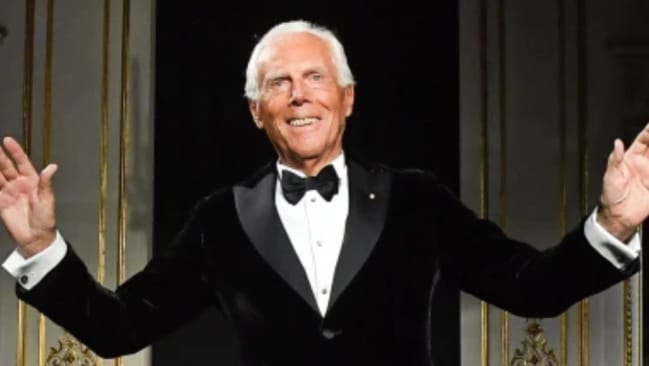Opinion When I met Giorgio Armani — the architect of quiet elegance
I felt an enormous sense of pride — volume of orders did not matter, but the fact that we had played a small part in his creative world meant everything to us
 His unconstructed suit jackets, made with lighter fabrics, added sensuality to suits, and earned him the title “King of the Blazer”.
His unconstructed suit jackets, made with lighter fabrics, added sensuality to suits, and earned him the title “King of the Blazer”. It is called serendipity. The first time I met Giorgio Armani was in 1994 — a chance meeting at the Oberoi hotel. I was with upcoming Italian textile designer Desolina Suter. She recognised him first, standing in the lobby of the hotel. We got into the elevator, following him, only to get a few minutes with the legend.
A maverick worth billions of dollars, Armani was always dressed simply, laid back. That day, he was wearing a charcoal tee and blue jeans. Upon approaching him, we realised he was unassuming, and humble. He was delighted to know we were colleagues, working in the field of design from India to the West. Our meeting may have lasted only for a few minutes, but it remains fresh in my memory.
How providence plays out in life is uncharted. Little did Desolina know, she would later be joining his company. She wrote a letter to Armani, securing a job when he was starting Armani Casa. I had the good fortune to be recommended to him by many people including Paola Navone, as well as the President of Armani at that time, Fabrice Gouffran, whom I had worked with previously for another international company.
I was selected as a sourcing agent for Armani Casa before its launch. The interaction was intense as Armani himself was involved in every aspect of the business. I was immersed in product development — from textile, metal, fashion, scarves, craft items, paper, wood to glass products. We made 70 products, and left it to Mr Armani and his team, to make final selections. Though he never came on the line, nor spoke to us directly, he communicated through his team.
In 2000, Armani Casa was launched. I won a personal invitation to Milan as his valued guest. I rubbed shoulders with royalty, the best from the modelling world, Hollywood actors, celebrities I didn’t know but instantly recognised, like the legendary Sophia Loren and the inimitable Robert de Niro, at this party.
I was dressed in a Rajesh Pratap bandhgala and Jodhpurs, to look the India part — quite a contrast to Mr Armani, who, again, chose to dress in a t-shirt. Till this day, I haven’t been able to imbibe his simplicity and innate austerity. I was introduced to him formally as the person who got a range from India. I remember his warm smile and nod of approval. At a time when “Made in India” had not gained global status, creating products for his first-ever store and one handshake with him — these were enough for me!
Metal containers from Moradabad and glass vases from Firozabad were displayed at Armani Fiori. Impeccably tailored and textured cushion covers from Ahmedabad, silk quilts from Delhi exporters, horn and silver cutlery, handmade paper mats from Jaipur, duvet covers from Ahmedabad and Delhi exporters, woollen scarves from Amritsar, we did it all. I felt an enormous sense of pride — volume of orders did not matter, but the fact that we had played a small part in his creative world meant everything to us. Navone, Desolina, Gregorio Cappa, Marta Giardini, Corrado Dotti all took many trips to India for product development, as the Armani Casa business grew exponentially.
In 2008, when Mr Armani’s team was launching a hotel in Dubai, his office invited me to Milan. In his shy style, as he whizzed past me, his gaze fell on a cashmere blanket with nifty leather binding. Out of the many products we made, he appreciated this one piece. Aware of his love for cashmere, I took along a scarf as a gift for him.
Having Mr Armani’s account gave my business a massive boost. At 90, he said in an interview, “Work is the best medicine”. He knows this best, having founded his company in 1975 with nothing. This taught me a lot about running my own business; I’ve followed the mantra ever since.
After three years of study, he quit medical school and became an assistant menswear buyer for the Italian department store chain La Rinascente. Then, he moved to Cerruti 1881, where he designed men’s clothes. But he never forgot his roots working as a window dresser.
I was a big fan of his lining-less sports jacket of the ’70s, the historic Armani suit that became the company’s flagbearer, just like the pantsuit for working girls — revolutionary on so many levels, termed the “power suit”. In the ’80s, shoulder-padding and tailored trousers became a staple for rising businesswomen opening doors of the corporate arena. He was the architect of quiet elegance, and understated luxury.
His unconstructed suit jackets, made with lighter fabrics, added sensuality to suits, and earned him the title “King of the Blazer”. This suit, with its classic tailoring and muted tones, went down in history when Richard Gere donned it in “American Gigolo”. For me, he will always be the man who could effortlessly mix softness into a world that saw men’s suits only as checks and plaids. Your legacy remains alive; it will never fade away, King Armani!
The writer is chairman, Fashion Design Council of India






